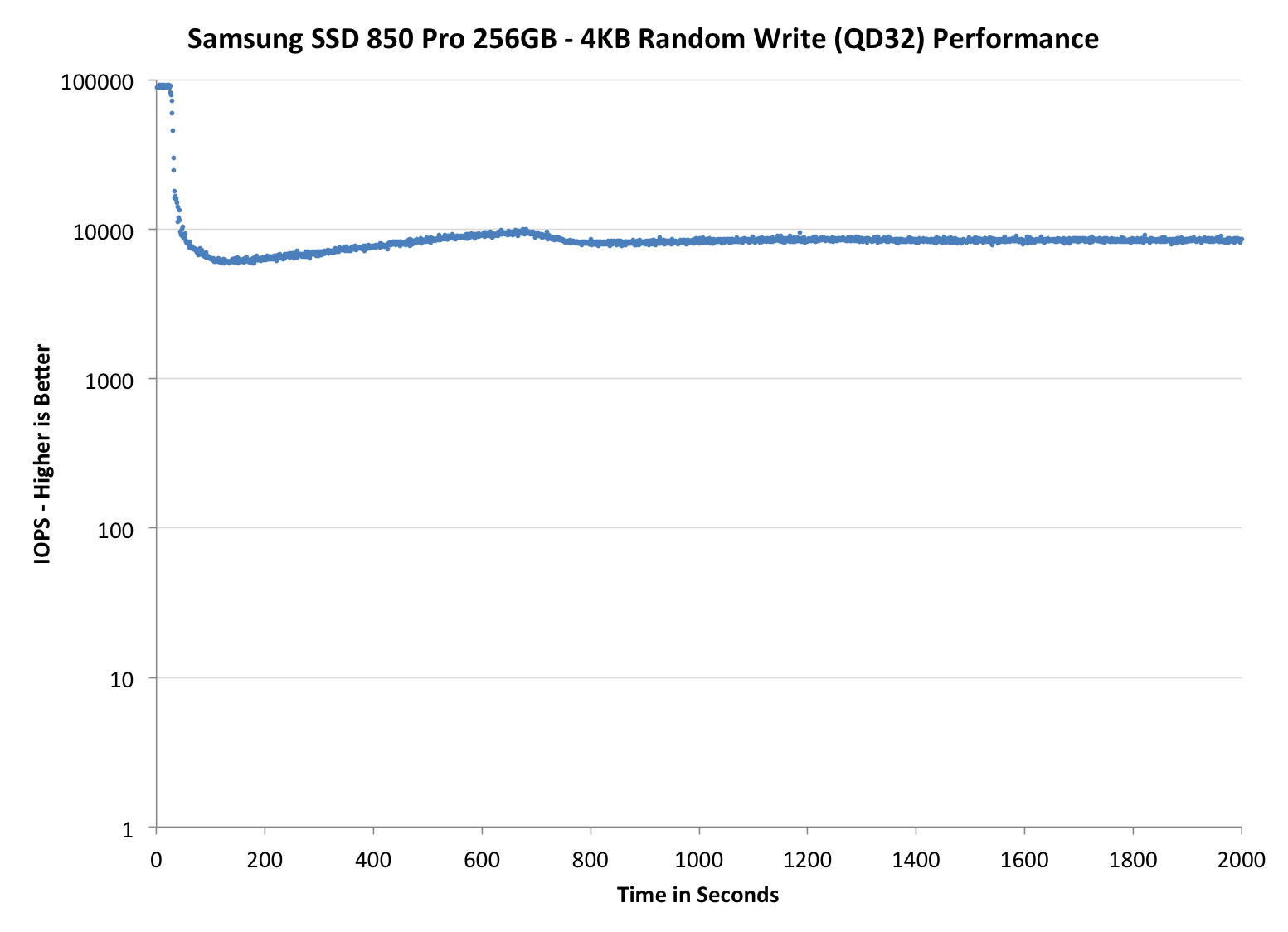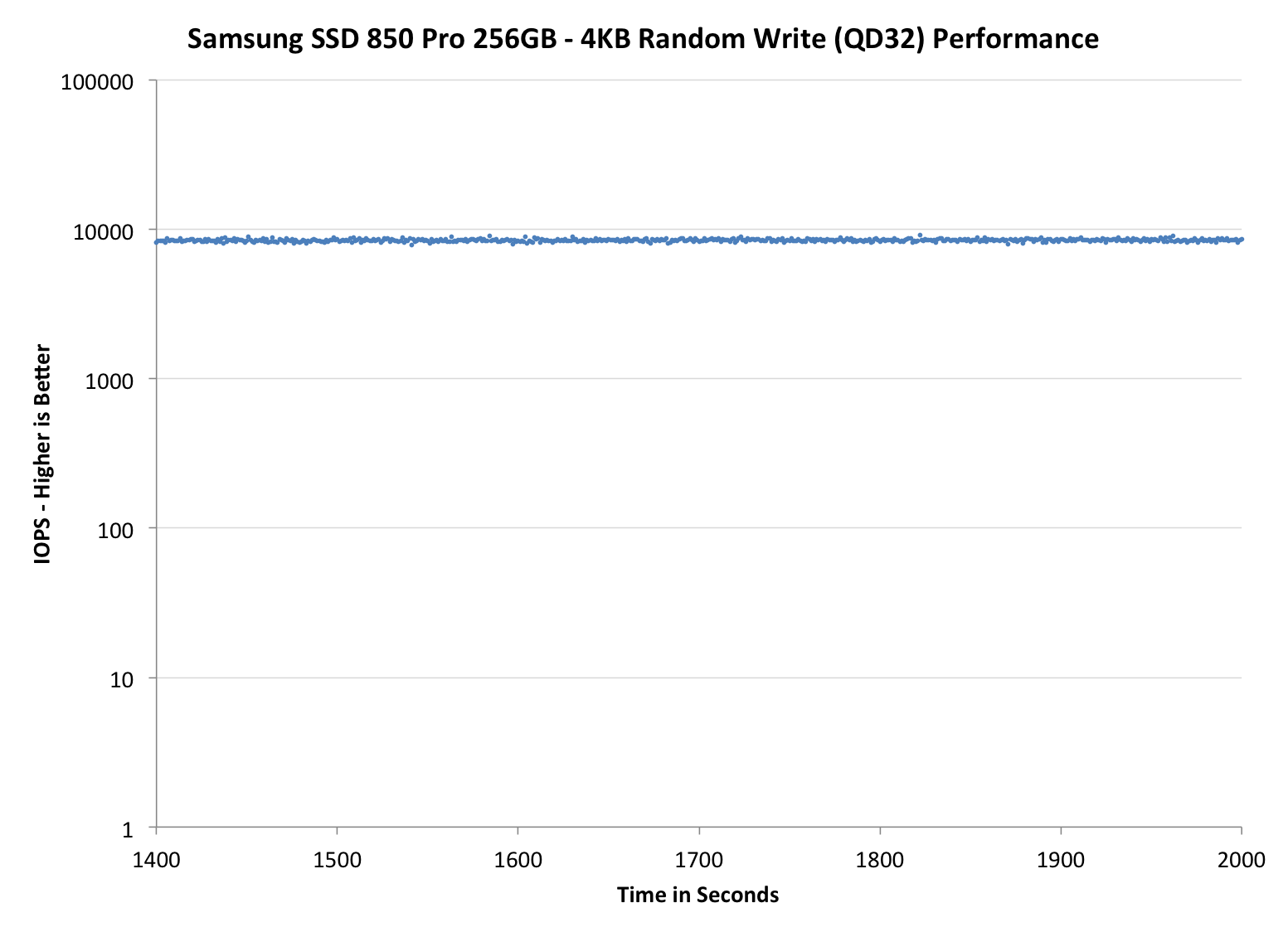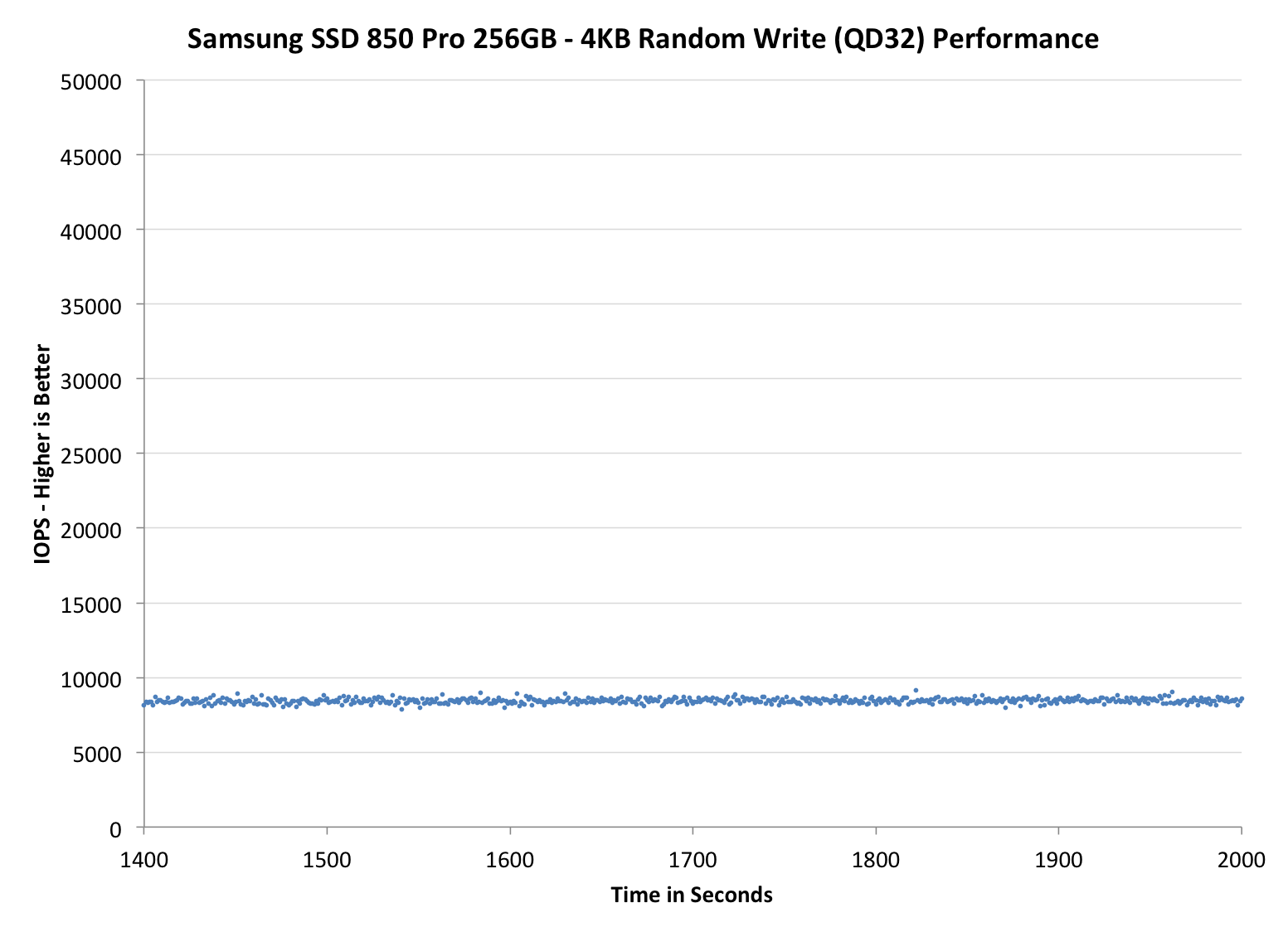Samsung SSD 850 Pro (128GB, 256GB & 1TB) Review: Enter the 3D Era
by Kristian Vättö on July 1, 2014 10:00 AM ESTPerformance Consistency
Performance consistency tells us a lot about the architecture of these SSDs and how they handle internal defragmentation. The reason we don’t have consistent IO latency with SSD is because inevitably all controllers have to do some amount of defragmentation or garbage collection in order to continue operating at high speeds. When and how an SSD decides to run its defrag or cleanup routines directly impacts the user experience as inconsistent performance results in application slowdowns.
To test IO consistency, we fill a secure erased SSD with sequential data to ensure that all user accessible LBAs have data associated with them. Next we kick off a 4KB random write workload across all LBAs at a queue depth of 32 using incompressible data. The test is run for just over half an hour and we record instantaneous IOPS every second.
We are also testing drives with added over-provisioning by limiting the LBA range. This gives us a look into the drive’s behavior with varying levels of empty space, which is frankly a more realistic approach for client workloads.
Each of the three graphs has its own purpose. The first one is of the whole duration of the test in log scale. The second and third one zoom into the beginning of steady-state operation (t=1400s) but on different scales: the second one uses log scale for easy comparison whereas the third one uses linear scale for better visualization of differences between drives. Click the buttons below each graph to switch the source data.
For more detailed description of the test and why performance consistency matters, read our original Intel SSD DC S3700 article.
 |
|||||||||
| Samsung SSD 850 Pro | Samsung SSD 840 Pro | SanDisk Extreme Pro | Intel SSD 730 | OCZ Vector 150 | |||||
| 7% Over-Provisioning | - | - | - | ||||||
| 12% Over-Provisioning | |||||||||
| 25% Over-Provisioning | |||||||||
Wow, this is awesome. Even with the default 7% over-provisioning, the 850 Pro is pushing almost as many IOPS as the Extreme Pro with its 12% over-provisioning. When the over-provisioning is increased to the same 12% level, the 850 Pro is a leader without a doubt. Only the Vector 150 can come close, although it is nowhere hear as constant as the IOPS is ranging between 10K and 30K, whereas the 850 Pro can maintain a steady line.
When compared with the 840 Pro, the upgrade is tremendous. IO consistency was always the weak point of the 840 Pro, so it is great to see that Samsung has paid a great effort to fix that in the 850 Pro. A part of the performance increase obviously comes from the usage of V-NAND because with shorter program and erase latencies, the steady-state performance increases as the garbage collection takes less time and there are more empty blocks available.
Some of you may wonder the odd capacities at 25% over-provisioning but the reason is that I noticed an error in the old ones. Basically, the old 25% numbers were in gibibytes (i.e. 1024^3 bytes) whereas the other capacities have always been in gigabytes (1000^3 bytes). I decided to unify the capacities and now they are all reported in gigabytes. The actual testing or over-provisioning levels have not changes -- it is simply a matter of how the capacities are represented.
 |
|||||||||
| Samsung SSD 850 Pro | Samsung SSD 840 Pro | SanDisk Extreme Pro | Intel SSD 730 | OCZ Vector 150 | |||||
| 7% Over-Provisioning | - | - | - | ||||||
| 12% Over-Provisioning | |||||||||
| 25% Over-Provisioning | |||||||||
 |
|||||||||
| Samsung SSD 850 Pro | Samsung SSD 840 Pro | SanDisk Extreme Pro | Intel SSD 730 | OCZ Vector 150 | |||||
| 7% Over-Provisioning | - | - | - | ||||||
| 12% Over-Provisioning | |||||||||
| 25% Over-Provisioning | |||||||||










160 Comments
View All Comments
Cerb - Tuesday, July 1, 2014 - link
"cheese in in" -> "cheese in it"?Cerb - Tuesday, July 1, 2014 - link
The above was meant to not be a reply to yours. In general, there's isn't much, though, because with SATA, we're still stuck needing striped RAID to improve bandwidth. Assuming they can keep costs in check, the rapid shrinking,m and thus capacity increases over the next few years, will give us something much more useful. That said, it's nice that they caught up in terms of consistency.Donuts123 - Sunday, July 6, 2014 - link
More relevantly, the 150TB warranty figure applies to all capacities. All things being equal, a 128GB drive with 150TB written will have the same amount of flash wear as a 1TB drive with 1200TB written.So in practice the 1TB model will have far higher endurance than 150TB. But its warranty will expire when its flash is only 12.5% worn. Samsung aren't the only manufacturer to have low TBW warranty figures; Micron/Crucial does it as well, with the same TBW figure for all drive capacities.
8steve8 - Tuesday, July 1, 2014 - link
Yawn. Another SATA 2.5" SSD.How does this compare to m.2 PCIe drives like the XP941 and M6e?
Will we see m.2 PCIe NVMe drives before xmas?
Kristian Vättö - Tuesday, July 1, 2014 - link
The 850 Pro is now in the Bench so you can compare the two easily:http://www.anandtech.com/bench/product/1201?vs=125...
8steve8 - Tuesday, July 1, 2014 - link
thanks, the XP941 demolishes this thing, why isn't it in the charts of this review? clearly PCIe m.2 would be on the radar for anyone looking for a high end SSD these days... ?it may not be readily available in the channels, but it is a taste of what is to come... personally I just got a 256GB plextor M6e PCIe m.2 for $220. It's easy to find in the market.
Kristian Vättö - Tuesday, July 1, 2014 - link
I didn't want to put the XP941 in the graphs because the availability and support are relatively limited and it would have broken some of the graphs.zmeul - Tuesday, July 1, 2014 - link
just a quick dumb question:the bandwidth for SATA 3.0 - 6 Gbit/s is 600 MB/s right? so, it's 300MB/s read and 300MB/s write
correct ?
thesavvymage - Tuesday, July 1, 2014 - link
no, its 600MB/s in total in either direction. you can max the 600 read if you arent doing any writes, etc. It isnt 300 max per direction, its 600 max for total data bandwidthzmeul - Tuesday, July 1, 2014 - link
yes, I forgot to mention, duplex (at the same time) 300r+300w